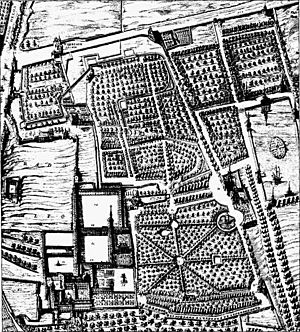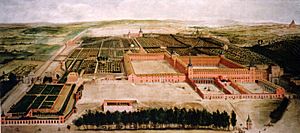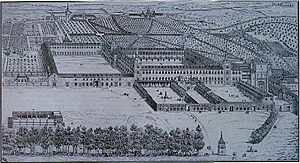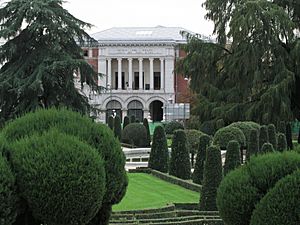Buen Retiro Palace facts for kids

The Buen Retiro Palace (Spanish: Palacio del Buen Retiro) was a huge palace in Madrid, Spain. It was designed by the architect Alonso Carbonell. King Philip IV of Spain ordered it to be built as a second home. He used it for fun and relaxation, which is why it was called "Buen Retiro" (meaning "Good Retreat"). It was built on the eastern edge of Madrid at the time. Today, only a few parts of the palace and its gardens remain. They are now part of the famous Retiro Park.
History of the Palace
King Philip IV often stayed in some rooms connected to the San Jerónimo el Real monastery. These rooms were called the "Royal Quarters." This monastery was near where the Prado Museum is today. The king loved walking in a farm next to the monastery. This farm belonged to his favorite minister, Count-Duke of Olivares.
To make the king happy, Olivares started building more rooms and buildings in 1629. These new parts were added to the Royal Quarters. Over time, they grew into the huge Buen Retiro Palace. The palace wasn't planned all at once. Instead, new parts were added over seven years, until 1640. When it was finished, the palace had more than 20 buildings. It also had two large open squares for royal parties and events. The whole palace was surrounded by huge gardens and ponds. This made it a very playful and relaxing place.
The king only spent a few days a year at his second home, usually in the summer. However, a lot of effort was put into decorating the palace with amazing art. It was meant to be as grand as the Royal Alcazar of Madrid, which was his main home. It was hard to find old paintings to buy. So, new paintings were ordered from Rome and Naples. Many of these paintings are now in the Prado Museum. Some famous ones include landscapes by Claude Lorrain and Nicolas Poussin. There were also Bible and mythology scenes by Massimo Stanzione.
For the Salón de Reinos (the royal reception room), a special series of paintings was ordered. These paintings showed important Spanish military victories. One of the most famous is The Surrender of Breda by Diego Velázquez. Other artists like Francisco Zurbarán and Juan Bautista Maíno also painted for this room.
The Buen Retiro Palace was a royal home until the late 1700s. In 1734, the Royal Alcazar of Madrid burned down. After that, the Buen Retiro Palace became the main home for the royal court. It stayed that way until the new Royal Palace of Madrid was finished in 1764.
The palace was built very quickly and with low-quality materials. This led to its downfall. In 1808, during the Peninsular War, French soldiers used the palace as their barracks. They stored gunpowder in the gardens and built a bunker. This caused a lot of damage to the area. The buildings themselves were also badly damaged. Later, when Queen Isabella II of Spain tried to fix it, it was too damaged to save. Most of the palace had to be torn down.
What Remains Today
The main part of the palace complex that is still here is the Retiro Park gardens. However, these gardens do not look like the original design. They are also only about half the size of the original gardens. Two other buildings from the palace still stand. They have been changed a lot from how they first looked. Both are now part of the Prado Museum complex:
- The Hall of Realms (or Salón de Reinos) was once the royal reception room with a throne. It was decorated with paintings that celebrated the generals who worked for the Duke of Olivares. Later, it became part of the museum area around the Prado. For many years in the 1900s, it housed the army museum (Museo del Ejército). This museum moved to the Alcázar de Toledo in 2010–2012.
- The Salón de Baile (the ballroom) is now known as the Casón del Buen Retiro. It used to hold the Prado's 19th-century art collections. Now, it is home to the Study Center of the Prado Museum. The ceiling of its main room has a beautiful fresco by the Italian artist Luca Giordano. He painted it around 1696–1697 for King Charles II of Spain. It shows "The Apotheosis of the Spanish Monarchy."
See also
 In Spanish: Palacio del Buen Retiro para niños
In Spanish: Palacio del Buen Retiro para niños
- List of missing landmarks in Spain




